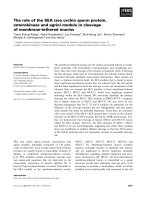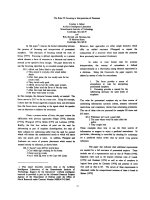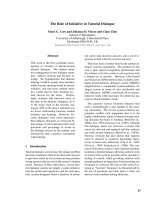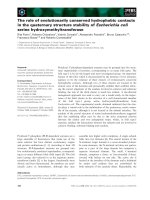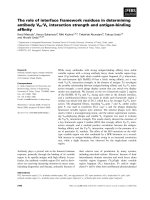Báo cáo khoa học: "The role of high-frequency oscillatory ventilation in paediatric intensive care" pot
Bạn đang xem bản rút gọn của tài liệu. Xem và tải ngay bản đầy đủ của tài liệu tại đây (31.52 KB, 2 trang )
249
ARDS = acute respiratory distress syndrome; DAD = diffuse alveolar disease; HFOV = high-frequency oscillatory ventilation; OI = oxygenation
index; SAD = small airway disease; VILI = ventilator-induced lung injury.
Available online />Abstract
Mechanical ventilation during acute respiratory failure in children is
associated with development of ventilator-induced lung injury.
Experimental models of mechanical ventilation that limit phasic
changes in lung volumes and prevent alveolar overdistension
appear to be less damaging to the lung. High-frequency oscillatory
ventilation, using very small tidal volumes and relatively high end-
expiratory lung volumes, provides a safe and effective means of
delivering mechanical ventilatory support with the prospect of
reducing the development of ventilator-induced lung injury. Despite
theoretical advantages and convincing laboratory data, however,
the use of high-frequency oscillatory ventilation in the paediatric
population has not yet been associated with significant improve-
ments in clinically significant outcome measures.
Introduction
In this issue of Critical Care, Slee-Wijffels and colleagues [1]
report on the use of high-frequency oscillatory ventilation
(HFOV) as a rescue therapy for children with severe respiratory
failure in the paediatric intensive care unit. They describe 51
children with severe respiratory failure, initially managed with
conventional mechanical ventilation, who required HFOV as
rescue therapy. In this retrospective study, the authors looked
for differences between patients with a diagnosis of diffuse
alveolar disease (DAD; 63% of the sample) and those with a
diagnosis of small airway disease (SAD; 33% of the sample).
Oxygenation index (OI) was significantly higher before and
during HFOV in DAD patients than in SAD patients, whereas
the arterial carbon dioxide tension before commencing HFOV
was higher in SAD patients than in DAD patients. The overall
survival rate was 64%, with 56% survival among DAD patients
versus 88% in patients with SAD.
Slee-Wijffels and colleagues postulate that earlier instigation
of HFOV may improve the outcome of children with
respiratory failure secondary to DAD, and suggest that HFOV
should be considered a rescue therapy for respiratory failure
in SAD – a clinical condition in which HFOV is often avoided
because of the perceived risk for worsening pulmonary
overdistension.
Discussion
Acute respiratory distress syndrome (ARDS) is the most
severe form of acute lung injury and is often quoted as having
a mortality rate of around 30%. ARDS can be defined
according to the American–European Consensus Conference
Committee criteria: acute onset; presence of bilateral
infiltrates on chest radiography; arterial oxygen tension/
inspired fractional oxygen index < 200; and absence of
clinical evidence for left-sided heart failure. Treatment is
largely supportive, with mechanical ventilation, and is
associated with the development of so-called ventilator-
induced lung injury (VILI).
There are a number of mechanisms that can lead to
development of VILI. These include production of gross air
leaks; diffuse alveolar injury due to overdistension; injury due
to repeated cycles of recruitment/derecruitment, in which
alveolar units open during inspiration and collapse again
during expiration, resulting in the generation of high shear
stress; and damage due to the release of inflammatory
mediators in the lung. These processes are often referred to
as ‘barotrauma’, ‘volutrauma’, ‘atelectrauma’ and ‘biotrauma’,
respectively.
The lungs of patients with ARDS are almost inevitably
heterogeneously damaged, and mechanical ventilation with
normal or even low tidal volumes can lead to regional lung
injury through the mechanisms described above. There is a
Commentary
The role of high-frequency oscillatory ventilation in paediatric
intensive care
Stephen D Playfor
Consultant Paediatric Intensivist, Honorary Clinical Lecturer in Paediatric Intensive Care Medicine, Paediatric Intensive Care Unit, Royal Manchester
Children’s Hospital, Manchester, UK
Corresponding author: Stephen D Playfor,
Published online: 18 April 2005 Critical Care 2005, 9:249-250 (DOI 10.1186/cc3524)
This article is online at />© 2005 BioMed Central Ltd
See related research by Slee-Wijffels et al. in this issue [ />250
Critical Care June 2005 Vol 9 No 3 Playfor
considerable amount of laboratory data suggesting that
repetitive cycles of pulmonary recruitment and derecruitment
are associated with demonstrable markers of lung injury.
Similarly, experimental models of mechanical ventilation that
limit phasic changes in lung volumes, prevent alveolar
overdistension and reverse atelectasis appear histologically
to be less damaging to the lung [2]. Recognition of the issues
surrounding VILI has led to the development of various lung-
protective ventilatory strategies, with the aim of reducing the
magnitude of damaging cyclic alveolar fluctuations through
the application of higher positive end-expiratory pressure
levels and by reducing tidal volumes. These goals may be
achieved using conventional ventilation, and in 2000 the
ARDSNetwork investigators [3] reported a 9% decrease in
absolute mortality in adult patients with ARDS using a lung-
protective strategy involving the use of small tidal volumes
(6 ml/kg predicted body weight) together with an average
positive end-expiratory pressure of 10 cmH
2
O. A similar
strategy may be pursued using HFOV, where adequate gas
exchange can be achieved while using extremely small tidal
volumes in the range 1–3 ml/kg (often less than the anatomical
dead space) and where it is possible to maintain relatively high
end-expiratory lung volumes without inducing overdistension.
Many of the available data regarding the use of HFOV in the
paediatric population are derived from case series in which
the therapy was offered to children with severe respiratory
failure secondary to diffuse alveolar disease and air leaks.
These case series suggest that HFOV can be safely used as
rescue therapy in this clinical setting, and that its use is
associated with improvements in oxygenation and carbon
dioxide clearance without worsening air leaks [4].
The first and largest randomized clinical trial examining the
effects of HFOV in children was the cross-over study
reported by Arnold and colleagues [5], in which 70 patients
with DAD and/or air leaks were randomly assigned to receive
either conventional ventilation, using a strategy that limited
the peak inspiratory pressure, or HFOV. The study found no
difference in terms of survival or in the duration of mechanical
ventilation, but it did demonstrate that significantly fewer
patients receiving HFOV remained dependent on
supplementary oxygen therapy at 30 days. In that study the
OI was shown to discriminate between survivors and
nonsurvivors in the first 24 hours of therapy, and an OI of 42
or greater at 24 hours predicted mortality with an odds ratio
of 20.8, sensitivity of 62% and specificity of 93%. This
finding is consistent with that of Slee-Wijffels and colleagues
[1], who noted a higher range of OI values in the DAD group,
in which the mortality was higher than in the SAD group.
Another significant finding of the study conducted by Arnold
and coworkers was that, in a post hoc analysis, the benefits
were not as great in the group that crossed over to the HFOV
treatment arm, supporting suggestions, including those by
Slee-Wijffels and colleagues [1], that HFOV may be more
effective when used earlier in the disease process.
Conclusion
Despite considerable laboratory data supporting the use of
HFOV in the treatment of severe respiratory failure in children,
studies in the paediatric population have not been able to
demonstrate any significant improvements in clinically
significant outcome measures [6]. This may be due to the
wide range of aetiologies of acute respiratory failure in the
paediatric intensive care unit, together with a gradual trend
toward the use of more protective conventional ventilation
strategies that emphasize lung recruitment and minimize tidal
volumes. The report by Slee-Wijffels and colleagues [1]
serves to remind us of the continuing high mortality in
children with severe respiratory failure secondary to DAD,
and emphasizes the need for large-scale, prospective,
randomized controlled trials to clarify fully the role of HFOV in
its management.
Competing interests
The author(s) declare that they have no competing interests.
References
1. Slee-Wijffels FYAM, van der Vaart KRM, Twisk JWR, Markhorst
DG, Plötz FB: High Frequency Oscillatory Ventilation in Chil-
dren: a single center experience of 53 cases. Crit Care 2005,
9:R274-R279.
2. Froese AB, Kinsella JP: High-frequency oscillatory ventilation:
Lessons from the neonatal/pediatric experience. Crit Care
Med 2005, 33:S115-S121.
3. The Acute Respiratory Distress Syndrome Network: Ventilation
with lower tidal volumes as compared with traditional tidal
volumes for acute lung injury and the acute respiratory dis-
tress syndrome. N Engl J Med 2000, 342:1301-1308.
4. Arnold JH, Anas NG, Luckett P, Cheifetz IM, Reyes G, Newth CJ,
Kocis KC, Heidemann SM, Hanson JH, Brogan TV, Bohn DJ:
High frequency oscillatory ventilation in pediatric respiratory
failure: a multicenter experience. Crit Care Med 2000, 28:
3912-3919.
5. Arnold JH, Hanson JH, Toro-Figuero LO, Gutierrez J, Berens RJ,
Anglin DL: Prospective, randomised comparison of high-fre-
quency oscillatory ventilation and conventional mechanical
ventilation in pediatric respiratory failure. Crit Care Med 1994,
22:1530-1539.
6. Ventre KM, Arnold JH: High frequency oscillatory ventilation in
acute respiratory failure. Paediatr Respir Rev 2004, 5:323-332.




